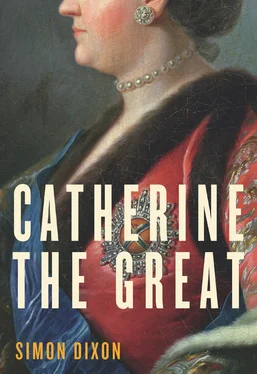No amount of festivity could disguise the harsh realities of Russian provincial society. The Yaroslavl merchants seemed so restive that, on her return to Moscow, Catherine sent a Guards officer to restore order and replaced the provincial governor. 36The brothers of the Fëdorov monastery at Gorodets irritated her even more. Suspicious of monks as an obstacle to Enlightenment, she had seen more than enough of them by the time she arrived there on 19 May to distinguish a well-run establishment from a disorderly one. As the Synod knew, theft and corruption were familiar problems, sometimes involving hundreds of thousands of roubles. 37Here, however, the empress encountered troubles of a different order. She could hardly have been welcomed more generously by the crowd who flocked to the quayside: Vladimir Orlov overheard one of the pious women who strewed shawls and silk scarves in her path refer to her as ‘a little apple’, another as ‘a little ray of sunshine’ and a third as ‘our benefactress’. 38Yet Catherine felt no warmth for the monks as they consecrated their new stone church. Behind its impressive façade, rebuilt from local funds after a fire in 1765, the monastery left much to be desired. Although it enjoyed a proud reputation as the place where St Alexander Nevsky had died in 1263, Abbot Zosima was too old and too ignorant even to say the liturgy properly and, as Catherine discovered, his disrespectful brothers ‘swore loudly while telling him how to do it’. She left them a derisory donation. 39
Worse still, the local clergy told her they were losing their flock (and with it their income) to the schism, which had put down tenacious roots deep in the forests around Nizhny Novgorod since Patriarch Nikon first split the Orthodox Church in the mid-seventeenth century. In their turn, the Old Believers, who had been outlawed by Tsar Aleksey Mikhailovich for resisting Nikon’s reforms to the liturgy, complained to Yelagin that Orthodox priests treated them ‘like Muslims’ and refused to christen their babies. Faced with such open discord, Catherine realised that there would be no easy route to the ‘tranquillity between citizens which prudence is everywhere trying to establish’. Since it was impossible to trust the local bishop—a ‘weak’ man who surrounded himself with ‘equally weak simpletons’ rather than seek out ‘clean-living clergy, enlightened by learning, and meek of morals’—she secretly urged Archbishop Dimitry to reform the diocese on the models of Novgorod and Tver. 40Insisting on civilised clerical behaviour in the months after the cruise, she urged punishment for priests who extorted money from the Old Believers by violence. Yet the problem was at least in part one of her own making. While her own relatively generous legislation had alarmed the Synod by stimulating a rise in schismatic numbers in the mid-1760s—the official figure of 10,697 reported by the diocese of Nizhny Novgorod in 1765 was surely an underestimate—none of the older, repressive edicts had been repealed. As a result, aggressive clergy were able to exploit precisely the sort of confused legal position that the Legislative Commission was intended to correct, exposing the limits of Catherine’s much-vaunted commitment to religious toleration. Although she continued to condemn the degradation of the Old Believers in the combined causes of humanity and civil tranquillity, she had no intention of undermining the privileged status of the Orthodox Church. As a perceptive Times correspondent noted a century later, it was to remain a feature of ‘the peculiar relations between Church and State’ in Russia that ‘the Government vigilantly protects the Church from attack, and at the same time prevents her from attacking her enemies’. 41
Perhaps it was her experiences at Gorodets that led Catherine to be more critical of Nizhny Novgorod than of the other places she had visited. Perhaps it simply failed to live up to the extravagant billing in the Geographical Description . At any rate, the empress found little to please her during her stay in Bishop Feofan (Charnutsky)’s palace. Perched high on a cliff above the Volga, the town’s situation was striking enough, and made the more attractive by the sunshine which had finally broken through. However, in an unconscious anticipation of the abbé Chappe d’Auteroche, Catherine declared Nizhny to be ‘abominably built’. 42Vladimir Orlov agreed: though the cathedral seemed in many ways the finest they had yet seen, there was ‘almost nothing worthy of remark’ in a town whose merchants seemed ‘very meagre’ in view of their advantageous position at the crossroads of Russian trade. 43Not content with decreeing the reconstruction of its principal public buildings, Catherine immediately set about founding a new trading company to boost the local economy. 44News of the impending bankruptcy of the British timber merchant William Gomm seemed to confirm all her suspicions about privileged manufacturers. Demanding ‘precise accounts’ of his various activities, which ranged from tobacco to iron, she was inclined to ‘conclude that all these are sustained out of state money’. 45One of the few bright spots in the visit was when Orlov introduced her to a local inventor, Ivan Kulibin, the protégé of an Old Believer merchant who delighted her with a microscope and telescope. She would see him again in St Petersburg when he had perfected his clock in the form of a mechanical golden egg. 46
As her galley weighed anchor on 23 May, Catherine was leaving the longest settled Russian lands for the intersection of the Orthodox and Islamic worlds. She had given her first audience to a Tatar delegation at Kostroma. 47Now she was entering an area where a brutal missionary campaign, sponsored by Church and state in the early 1740s, had culminated in the forcible mass baptism of some 400,000 Finno-Ugric people: Mordvins, Chuvash and Maris. The driving force behind the attack on ‘the vile Mordvin faith’ had been none other than Catherine’s trusty Archbishop Dimitry, who claimed to have barely escaped with his life when a group of Mordvins attacked his convoy in protest against the razing of a sacred burial ground. This incident led to reprisals by Russian troops and mass flight into the forest on the part of the native population. In the following decade, hundreds of mosques were destroyed, particularly in areas where they might ‘seduce’ converts to revert to their former ways. 48Though Orthodox missionary work had continued in a more emollient key under Catherine, who scarcely troubled to conceal her distaste for Elizabeth’s methods, violence was still a living memory in the Volga region in 1767. So it is perhaps no coincidence that no converts were presented to the empress at Kozmodemyansk or Cheboksary (‘superior to Nizhny Novgorod in every way’), or that she sailed straight past Svyazhsk, where the government office in charge of the conversions had been closed in 1764. 49A reminder of the deviant potential of popular Orthodoxy came at Kozmodemyansk, where a merchant presented her with an icon of the Holy Trinity with three faces and four eyes. She sent it to the Holy Synod, anxious lest ‘senseless icon-painters’ succumb to the temptation ‘to add several further arms and legs’ in the manner of Chinese paintings. Appalled by ‘such a ridiculous and unworthy image’, the Synod swiftly decreed that no more icons should be painted without the express permission of its own specialist artists. That was ‘all very well,’ Catherine retorted, but ‘scarcely possible in an empire of Russia’s dimensions’ since ‘it could give rise to a lot of pestering’. She required only that ‘all bishops be instructed that in future no such indecent images should be permitted in their dioceses’. 50
Had there been any doubt about the friendliness of the reception she could expect in Tatar territory, it was dispelled when the empress arrived at Kazan on the evening of 26 May. ‘All along the way my welcome has been equally affectionate,’ she told Adam Olsufyev, ‘only here it seems a degree higher owing to the rarity of their seeing me.’ 51Overlooking the point where the Volga carves out a majestic 90-degree turn to the south, Kazan is one of the most attractively situated towns in Russia. The decorations in honour of Catherine’s visit were no less impressive. She told Panin that the triumphal arches there were better than any she had so far seen. One of them had been designed by Julius von Canitz, director of the town’s high schools, founded at the instigation of Ivan Shuvalov to feed suitably qualified noble and non-noble entrants to Moscow University in 1758 (the poet Derzhavin was the most famous pupil). Struggling against unsympathetic neighbours, who littered the road to the schools with dung, Canitz increased the roll to a peak of 125 between his appointment in 1765 and 1773. But Vladimir Orlov found the institution ‘in a very bad condition’ in 1767, ‘with 12 teachers and only 40 pupils’ whose speeches in German, French, Russian and Latin were ‘very imperfect’. Catherine did not visit the school, but she encouraged the provincial governor to revive the amateur theatricals that Canitz had instituted there as a way of fostering the ‘pleasant address and the savoir vivre essential in polite society’. 52
Читать дальше












